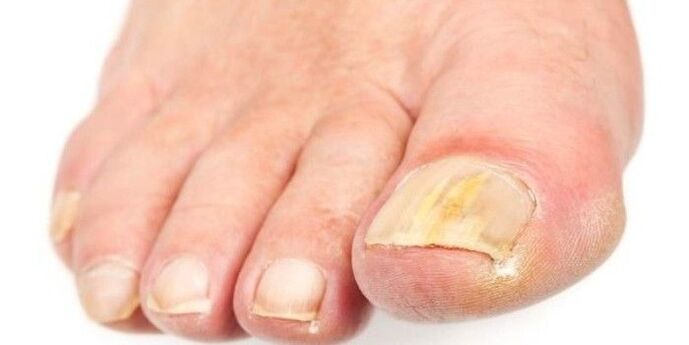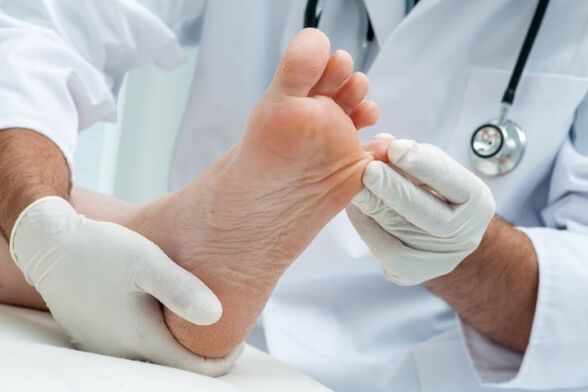Fungus, also known as onychomycosis, is a nail surface infection caused by dermatophytes, yeast or mold.
The color of the nails changes, it starts to get white, then darker and can smell bad. Playing, deforming, starting to collapse.
There is a high probability that the infection can spread to other nails on the feet and skin adjacent. Pain will appear while walking, wearing shoes. Therefore, the fungus must be treated on time.
The cause of nail fungus

Causes -The cause of onychomycosis is quite shallow:
- Call with any microscopic mushrooms anywhere. Another question is that nails are exposed to infection when someone walks barefoot in a damp place - swimming pool, locker room and shower is perfect for fungus.
- Damaged nails, cracks, injured fingers, infections with bacteria or other pus provide mild dermatophytes into the body.
- If a person has chronic diseases, such as diabetes, peripheral vascular disease and immunodeficiency conditions, then Class A candidate for fungal infection.
In the event of irritation, the feet are sweating a lot, and the shoes are narrow and less ventilated for a long time - this is an ideal environment for the growth of disputes.
Symptoms of nail fungus
The most common symptom caused by fungal infection is the thickening of the plate. Nails can be bleached, have white, black, yellow or green.
With the development of the disease, it becomes fragile, small pieces of nails break or can be completely separated from the fingers. If you do not pay attention, the skin underneath, becomes painful, scaly. An unpleasant odor occurs
If the disease does not work, there are usually no other symptoms. Sometimes the body can respond to fungus in skin that is free from damage. Rash or itching caused by dermatophytes can be an allergic reaction to the fungus.
Risk factors for nail fungus development
Any people can have an infection on the toes, but there are certain risk factors that make one more easily infected with fungal nails. Some of them are as follows:
- Action is a major risk factor for nail fungus. As people grow older, the quality of blood vessels is reduced, and blood supply to the peripheral area is disrupted, which is why there is a moisture of nail growth and general vulnerability to infection.
- Men's floors are more likely to have nail fungus.
- Increased sweating, as well as if someone works in a damp environment, for example, delete, wash, clean or cook food.
- Wearing socks and shoes prevents ventilation of the skin, and synthetic materials do not absorb sweat, so choose cotton products.
- The risk of contagine, if you live with people with nail fungus - CO and you can be infected.
- Walking barefoot in the raw place, such as swimming pools, gyms and baths.
- Irritation between fingers, itching, peeling, skin or nail injury, psoriasis.
- Chronic diseases, such as diabetes, peripheral vascular disease, weak immunity and certain syndrome, such as Down syndrome.
Fungal complications
Severe infections of the feet can be very painful and cause persistent damage to your nails. If a person has a stressful immune system, diabetes or other chronic diseases, there is a high risk of complications. With diabetes, blood circulation decreases and neuropathy often occurs. Sometimes you can't see the pain.
Therefore, not only the fungus for the nails, but also a slight injury to the foot can be a serious problem. If a person has diabetes, and he feels there is an infection, it is reasonable to visit a doctor.
Test and diagnostic
Nail fungal infections are sometimes not diagnosed as psoriasis, dermatitis and tumors, such as melanoma. To avoid the wrong diagnosis, laboratory tests may be required.
As a rule, three approaches are used:
- The first is a smear cooked using potassium hydroxide.
- Second, it is a culture of contagious organisms.
- The third is the confirmation of the body's histological.
The three approaches use microscopic studies of the nails obtained by scrapers or trimming.
According to some of these new improvements -recently, from the point of view, the most useful are direct stroke, histological examination and nail plate biopsy using periodic acid spoons.
To properly diagnose the fungal organism, some samples may be needed.
Prevention

The first step that can be taken to prevent fungal infection in the foot is to observe proper hygiene. Pure and dry feet certainly prevent any fungal infections.
Make a thorough rinsing with soap and do not forget to dry it after the procedure. In public, you need to wear bath slippers.
You may need to change shoes, socks and underwear more than once a day.
Improve nail cutting techniques - cut them so that the nails do not go beyond your feet.
You may need to wear shoes that don't fit your fingers, and their materials should be ventilated.
Avoid wearing cotton stockings or wool. Prefer socks made of special synthetic fibers that take moisture from the feet more efficient than cotton and wool.
Drink nails and pedicures. Do not apply varnish to nails with infection.
When to see a doctor
Need to make an appointment with your doctor if the nail fungal infection causes a bacterial sign: you should check out the list of signs and symptoms for accurate diagnosis and proper drug choice.
The doctor will study the patient, hear the complaint, after the main test is conducted with a biomaterial accumulation to determine the type of fungus. Then complete analysis of the results and purposes of therapy.
Affordable treatment and medication
In the event of a mild fungal infection, there is no need for complex treatment. However, neglect can cause its spread to other nails. Here are the treatment options available for nail fungus:
Medications are usually recommended when a fungal nail infection is serious.
You may need to take the medication for several months so that the infection has disappeared. Drug stops will cause the relapse too early. Some side effects of the drug may include headaches, itching, loss of taste, nausea and diarrhea.
If one does not want to take the pill, the doctor will advise instead of using a nail. It is not as effective as the oral product, as it cannot penetrate deep into the nail to the focus of the infected area. The terms of use reach 12 months.
Nail removal
Abnormal nails can be chemically removed using a paste containing 40% urea. Pasta is easy to find in pharmacies. You need to attach it to the nails, close and leave it overnight. Rinse the pasta in the morning and repeat the procedure daily. The infected plate will be dissolved after about 2 weeks.
This is a non -painful treatment option that eliminates the patient with the nails, as well as gradually eliminating mycosis. With such treatment, it is not necessary to take the pill for several months and the surgery can be avoided.
Surgery and laser therapy
Surgery to remove infected nails is only recommended in difficult conditions, if it becomes very painful, and other methods of treatment do not help. After surgery, the nails will begin to grow again, however, a year may be needed for complete recovery.
Is laser treatment a good choice for eliminating nail fungus?
In the case of nail stubborn infections, laser treatment is possible. Laser emits high doses of light energy, which kills and destroys mushrooms.
According to research, laser therapy is safe, and the treatment rate is 90% after 3 months. However, it requires repetition every three months throughout the year and is not cheap.
How long can you treat nail fungus?
The treatment of nail infections can be a long and expensive process.
Perfect medicine works on an average of about four months, while the infected nails are replaced healthy.
When using antifungal nail polish, the duration of treatment increases and can take about one year.
Laser removal and surgery provide faster results.
















